 Welcome to our discussion on King of the Bridge by Finn Schuuring. As a fan of innovative design, I love how both the developer and publisher poured their heart into this game. Its mix of chess mechanics with over 20 odd, mind-bending rules is a real treat, and on top of that, the gameplay depth challenges you to decipher and adapt every single move. Though the learning curve can feel steep, it rewards players who relish mastering complex systems. That said, for someone like me—who thrives on competitive strategy and intricate detail—the constant need to counter cheats and plan out moves makes each match a deeply satisfying mental duel.
Welcome to our discussion on King of the Bridge by Finn Schuuring. As a fan of innovative design, I love how both the developer and publisher poured their heart into this game. Its mix of chess mechanics with over 20 odd, mind-bending rules is a real treat, and on top of that, the gameplay depth challenges you to decipher and adapt every single move. Though the learning curve can feel steep, it rewards players who relish mastering complex systems. That said, for someone like me—who thrives on competitive strategy and intricate detail—the constant need to counter cheats and plan out moves makes each match a deeply satisfying mental duel.
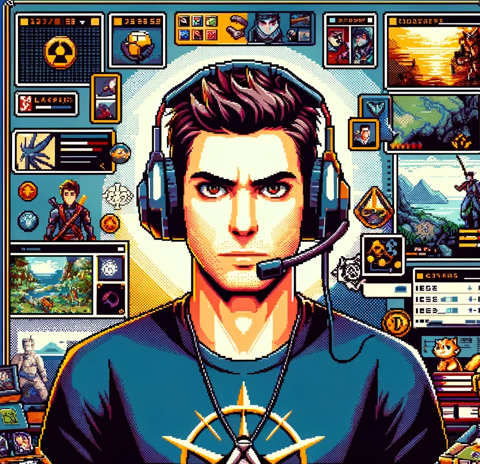 I completely agree, PlayerProX. King of the Bridge fascinates me with its rich tapestry of hidden rules and secrets. In fact, the detailed rulebook spans over 30 pages, filled with Easter eggs and cheat codes waiting to be discovered. What’s more, every dialogue line and collectible makes the game feel like an immersive treasure hunt. Some reviews mention they wanted even more weird rules, but I see this as an open invitation for us to dig deeper into the game’s layered design. In other words, it’s a playground for gamers who love checking every box and unearthing every hidden detail.
I completely agree, PlayerProX. King of the Bridge fascinates me with its rich tapestry of hidden rules and secrets. In fact, the detailed rulebook spans over 30 pages, filled with Easter eggs and cheat codes waiting to be discovered. What’s more, every dialogue line and collectible makes the game feel like an immersive treasure hunt. Some reviews mention they wanted even more weird rules, but I see this as an open invitation for us to dig deeper into the game’s layered design. In other words, it’s a playground for gamers who love checking every box and unearthing every hidden detail.
 For me, the journey through King of the Bridge has been a wild adventure. I love the excitement of uncovering bizarre chess moves and secret tricks as I go. The treacherous troll throws unexpected challenges at every turn, making the narrative both humorous and engaging. It reminds me of open-world adventures where each discovery feels fresh and fun. The game’s blend of witty dialogue and a quirky storyline keeps me coming back for more excitement and surprises.
For me, the journey through King of the Bridge has been a wild adventure. I love the excitement of uncovering bizarre chess moves and secret tricks as I go. The treacherous troll throws unexpected challenges at every turn, making the narrative both humorous and engaging. It reminds me of open-world adventures where each discovery feels fresh and fun. The game’s blend of witty dialogue and a quirky storyline keeps me coming back for more excitement and surprises.
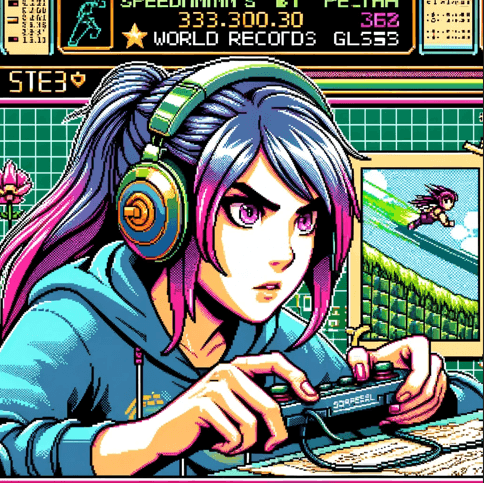 I’ve been focusing on the Speedrun and Speed Chess modes, and they offer an intense burst of adrenaline. The game’s fast-paced nature forces you to optimize every move. I love how the pixel art and smooth animations provide clear visual cues that are crucial when every second counts. Though its rule complexity might slow you down at first, once mastered, it rewards rapid decision-making. For speedrunners like me, this game is an exciting test of reflexes and strategy.
I’ve been focusing on the Speedrun and Speed Chess modes, and they offer an intense burst of adrenaline. The game’s fast-paced nature forces you to optimize every move. I love how the pixel art and smooth animations provide clear visual cues that are crucial when every second counts. Though its rule complexity might slow you down at first, once mastered, it rewards rapid decision-making. For speedrunners like me, this game is an exciting test of reflexes and strategy.
 Let’s dive into the gameplay mechanics. The controls remain intuitive despite constant rule changes, which pushes the boundaries of classic chess. Every move forces you to re-read the rules and strategize on the fly. It’s similar to how games like Portal challenge conventional thinking. I appreciate how the game merges strategy with environmental interactivity to keep every play session unpredictable.
Let’s dive into the gameplay mechanics. The controls remain intuitive despite constant rule changes, which pushes the boundaries of classic chess. Every move forces you to re-read the rules and strategize on the fly. It’s similar to how games like Portal challenge conventional thinking. I appreciate how the game merges strategy with environmental interactivity to keep every play session unpredictable.
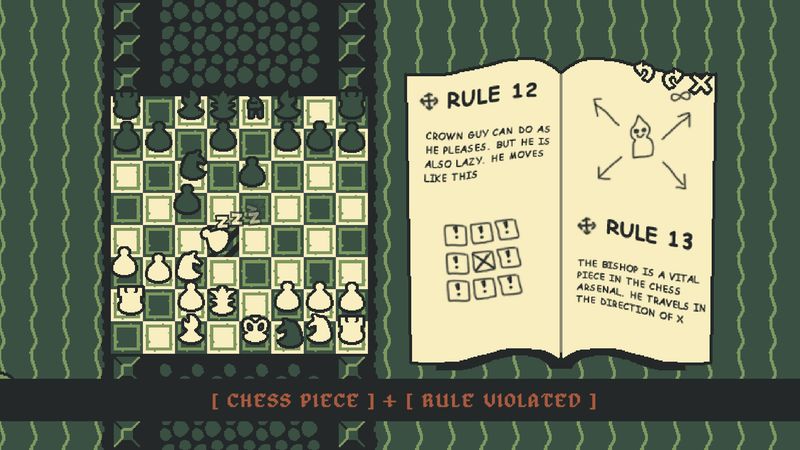
 I love how the mechanics go beyond the chessboard. The game encourages you to explore, find secret strategies, and even uncover hidden audiovisual cues. There are subtle visual hints in the pixel art and dialogue that reward investigation. Each detail adds to the overall depth, making the experience feel as complete as it is quirky.
I love how the mechanics go beyond the chessboard. The game encourages you to explore, find secret strategies, and even uncover hidden audiovisual cues. There are subtle visual hints in the pixel art and dialogue that reward investigation. Each detail adds to the overall depth, making the experience feel as complete as it is quirky.
 The narrative hooks you quickly with the eccentric troll and his playful mischief. The story twists, like accusing him of cheating, feel fresh and engaging. The dialogue is fun, and the game builds its lore gradually, which makes exploring the world very rewarding. I value how the narrative integrates with gameplay instead of overshadowing it.
The narrative hooks you quickly with the eccentric troll and his playful mischief. The story twists, like accusing him of cheating, feel fresh and engaging. The dialogue is fun, and the game builds its lore gradually, which makes exploring the world very rewarding. I value how the narrative integrates with gameplay instead of overshadowing it.
 On the mechanics side, King of the Bridge is brilliantly structured for speed. The crisp, responsive controls allow you to react to unexpected rule changes with precision. You can almost feel that every audio cue and animation is designed to prompt a quick decision, which fits perfectly for fast-paced runs.
On the mechanics side, King of the Bridge is brilliantly structured for speed. The crisp, responsive controls allow you to react to unexpected rule changes with precision. You can almost feel that every audio cue and animation is designed to prompt a quick decision, which fits perfectly for fast-paced runs.
 Moving on to visuals and graphics, the handcrafted pixel art is a standout. Every frame is carefully designed with a consistent color palette that emphasizes the game’s odd charm. Finn Schuuring clearly invested in an artistic direction that creates a lovely, nostalgic yet fresh atmosphere. It reminds me of other indie gems that value style just as much as substance.
Moving on to visuals and graphics, the handcrafted pixel art is a standout. Every frame is carefully designed with a consistent color palette that emphasizes the game’s odd charm. Finn Schuuring clearly invested in an artistic direction that creates a lovely, nostalgic yet fresh atmosphere. It reminds me of other indie gems that value style just as much as substance.
 I noticed small details in each scene that hint at hidden lore. The environments are interactive, and every pixel seems placed with purpose. This attention to detail improves the immersion, encouraging thorough exploration and replaying to catch things you might have missed the first time.
I noticed small details in each scene that hint at hidden lore. The environments are interactive, and every pixel seems placed with purpose. This attention to detail improves the immersion, encouraging thorough exploration and replaying to catch things you might have missed the first time.

 The retro-inspired art is charming and helps set a playful tone. The animations, though simple, pack personality into every move. The visuals enhance the story and keep the overall mood light, which is ideal for those moments when you’re discovering a new secret.
The retro-inspired art is charming and helps set a playful tone. The animations, though simple, pack personality into every move. The visuals enhance the story and keep the overall mood light, which is ideal for those moments when you’re discovering a new secret.
 For speedrunners, clear visuals are crucial. The design avoids distractions, letting you focus on reflexes and rule changes. The smooth transitions and well-timed effects are a big plus during high-speed challenges.
For speedrunners, clear visuals are crucial. The design avoids distractions, letting you focus on reflexes and rule changes. The smooth transitions and well-timed effects are a big plus during high-speed challenges.
 Audio is another area where King of the Bridge shines. The atmospheric soundtrack adapts to the ebb and flow of the game, adding to both tension and humor. The sound effects complement quick moves and strategic pauses, letting you know when subtle shifts in rules take place.
Audio is another area where King of the Bridge shines. The atmospheric soundtrack adapts to the ebb and flow of the game, adding to both tension and humor. The sound effects complement quick moves and strategic pauses, letting you know when subtle shifts in rules take place.
 I really value how the sound design layers in hints about secret rules. Background tracks and sound bites give subtle guidance and deepen the immersive experience. It proves that every component is designed with care.
I really value how the sound design layers in hints about secret rules. Background tracks and sound bites give subtle guidance and deepen the immersive experience. It proves that every component is designed with care.
 The soundtrack evokes a mix of retro charm and modern energy. The troll’s taunts and quirky voice lines are full of personality and really bring his character to life. It adds a fun, memorable quality to every encounter.
The soundtrack evokes a mix of retro charm and modern energy. The troll’s taunts and quirky voice lines are full of personality and really bring his character to life. It adds a fun, memorable quality to every encounter.
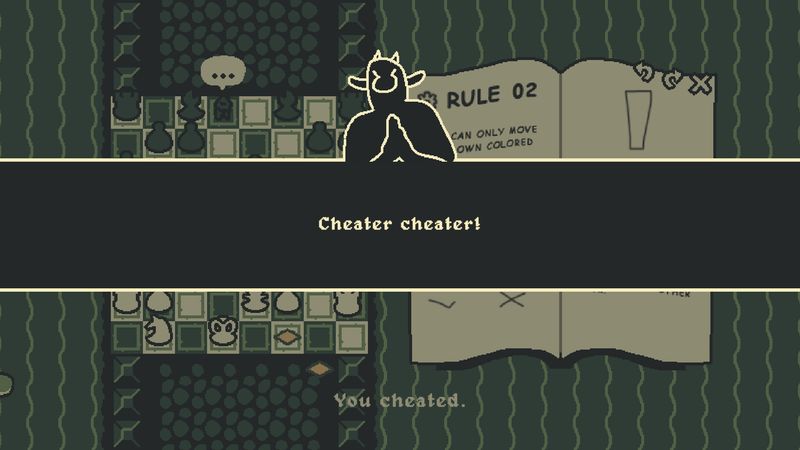
 For my speedruns, the clear audio cues are essential. They alert me when a rule change happens, helping me adjust my pace. The blend of dynamic music and sharp sound effects keeps me laser-focused on the challenge.
For my speedruns, the clear audio cues are essential. They alert me when a rule change happens, helping me adjust my pace. The blend of dynamic music and sharp sound effects keeps me laser-focused on the challenge.
 When it comes to characters, the troll stands out as a delightful villain. His antics, clever cheats, and taunts create a captivating dynamic that drives the narrative. The character design is smart and fits the playful yet cunning nature of the game.
When it comes to characters, the troll stands out as a delightful villain. His antics, clever cheats, and taunts create a captivating dynamic that drives the narrative. The character design is smart and fits the playful yet cunning nature of the game.
 The character depth shows through even in brief dialogues. I appreciate that hidden backstories unfold as you progress. Each subtle dialogue snippet and rule in the rulebook adds layers to the characters, which in turn enriches both story and strategy.
The character depth shows through even in brief dialogues. I appreciate that hidden backstories unfold as you progress. Each subtle dialogue snippet and rule in the rulebook adds layers to the characters, which in turn enriches both story and strategy.
 The quirky characters are very relatable in their own odd way. The troll’s mischief makes every encounter unpredictable, and his personality is infectious—adding a light-hearted tone to the challenges he presents.
The quirky characters are very relatable in their own odd way. The troll’s mischief makes every encounter unpredictable, and his personality is infectious—adding a light-hearted tone to the challenges he presents.
 Importantly, the characters are designed to support fast gameplay without bogging you down. They have enough personality to make the experience fun, yet the focus stays squarely on mastering the rules during rapid play sessions.
Importantly, the characters are designed to support fast gameplay without bogging you down. They have enough personality to make the experience fun, yet the focus stays squarely on mastering the rules during rapid play sessions.
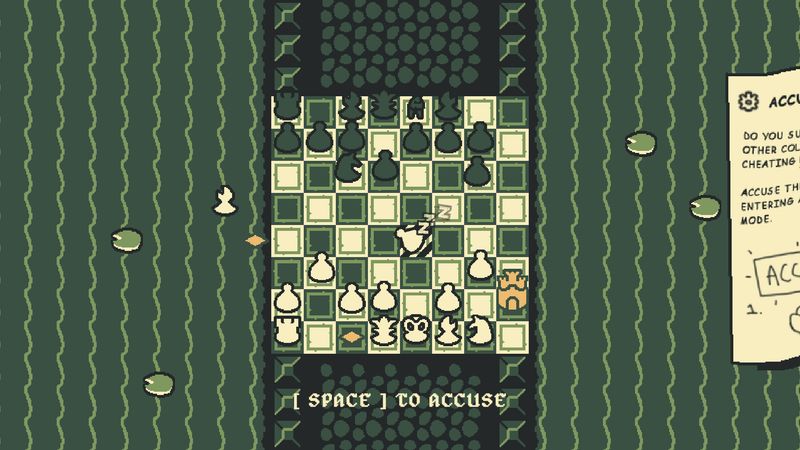
 Regarding challenge level, the game balances cerebral puzzles with occasional reflex-driven moments. The mix of strategic planning, cheat accusations, and quick responses provides a well-rounded challenge. As a result, it requires both thoughtful adjustment and rapid execution.
Regarding challenge level, the game balances cerebral puzzles with occasional reflex-driven moments. The mix of strategic planning, cheat accusations, and quick responses provides a well-rounded challenge. As a result, it requires both thoughtful adjustment and rapid execution.
 Some user feedback mentions that the learning curve is steep. I view it as a positive challenge that encourages you to study the rulebook and uncover every nuance. In that sense, the gradual difficulty increases keep the experience rewarding for dedicated players.
Some user feedback mentions that the learning curve is steep. I view it as a positive challenge that encourages you to study the rulebook and uncover every nuance. In that sense, the gradual difficulty increases keep the experience rewarding for dedicated players.
 The sporadic difficulty spikes are balanced by moments of light exploration and discovery. This pacing enables casual gamers to enjoy the story while still feeling the thrill of overcoming tough puzzles.
The sporadic difficulty spikes are balanced by moments of light exploration and discovery. This pacing enables casual gamers to enjoy the story while still feeling the thrill of overcoming tough puzzles.
 I like how the game offers different challenge modes. In particular, the Speedrun mode keeps me on my toes with fast decision-making and high-pressure scenarios. Each challenge tests a different aspect of gameplay, which is great for varied skill levels.
I like how the game offers different challenge modes. In particular, the Speedrun mode keeps me on my toes with fast decision-making and high-pressure scenarios. Each challenge tests a different aspect of gameplay, which is great for varied skill levels.
 Finally, let’s discuss replay value. King of the Bridge excels in providing multiple endings, secret unlockables, and a wealth of achievements that make repeat playthroughs worthwhile. Every new session lets you explore additional layers of strategy and narrative details.
Finally, let’s discuss replay value. King of the Bridge excels in providing multiple endings, secret unlockables, and a wealth of achievements that make repeat playthroughs worthwhile. Every new session lets you explore additional layers of strategy and narrative details.
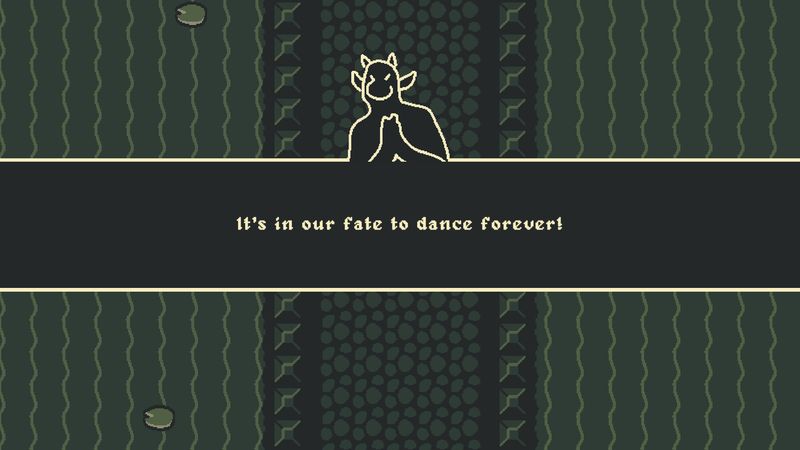
 Every play invites uncovering new Easter eggs and branching dialogue options. For completionists like me, the replayability here is a dream come true. It rewards careful exploration over many sessions.
Every play invites uncovering new Easter eggs and branching dialogue options. For completionists like me, the replayability here is a dream come true. It rewards careful exploration over many sessions.
 The adventure never feels stale, and even after a complete run, unexpected twists keep the experience fresh. Plus, its design encourages trying different strategies and approaches—perfect for gamers who thrive on discovery.
The adventure never feels stale, and even after a complete run, unexpected twists keep the experience fresh. Plus, its design encourages trying different strategies and approaches—perfect for gamers who thrive on discovery.
 The varied modes, such as Speed Chess, combine to offer fresh challenges even after multiple runs. Each playthrough can be a race against your best times while also uncovering new rule combinations.
The varied modes, such as Speed Chess, combine to offer fresh challenges even after multiple runs. Each playthrough can be a race against your best times while also uncovering new rule combinations.
 In final thoughts, King of the Bridge is a unique blend of chess, puzzles, and strategy. Finn Schuuring’s work stands out with its innovative game design and attention to detail. Consequently, the game caters to competitive strategists, detail hounds, adventurers, and speedrunners alike.
In final thoughts, King of the Bridge is a unique blend of chess, puzzles, and strategy. Finn Schuuring’s work stands out with its innovative game design and attention to detail. Consequently, the game caters to competitive strategists, detail hounds, adventurers, and speedrunners alike.
 I am genuinely excited by the game’s depth and hidden layers, even if its learning curve requires extra effort. Every secret and achievement makes each playthrough worthwhile.
I am genuinely excited by the game’s depth and hidden layers, even if its learning curve requires extra effort. Every secret and achievement makes each playthrough worthwhile.

 I wholeheartedly recommend this game to anyone looking for a quirky, fun, and adventurous twist on classic chess mechanics. It’s a rollercoaster of clever challenges.
I wholeheartedly recommend this game to anyone looking for a quirky, fun, and adventurous twist on classic chess mechanics. It’s a rollercoaster of clever challenges.
 If you love a fast-paced, constantly evolving challenge, dive into King of the Bridge and master its rules. It’s a fresh experience that promises endless replayability and thrills.
If you love a fast-paced, constantly evolving challenge, dive into King of the Bridge and master its rules. It’s a fresh experience that promises endless replayability and thrills.
 For similar experiences try these: Chess Ultra, which updates traditional chess with modern visuals and fresh gameplay twists. Portal offers mind-bending puzzles with engaging narrative humor. Antichamber challenges conventional logic with a surreal atmosphere. The Talos Principle provides deep, philosophical puzzles that blend narrative with challenging gameplay.
For similar experiences try these: Chess Ultra, which updates traditional chess with modern visuals and fresh gameplay twists. Portal offers mind-bending puzzles with engaging narrative humor. Antichamber challenges conventional logic with a surreal atmosphere. The Talos Principle provides deep, philosophical puzzles that blend narrative with challenging gameplay.

